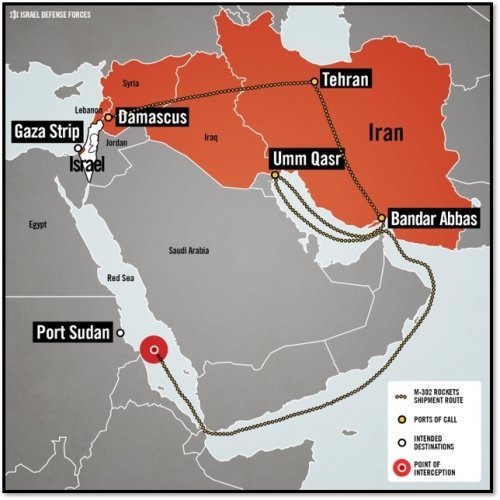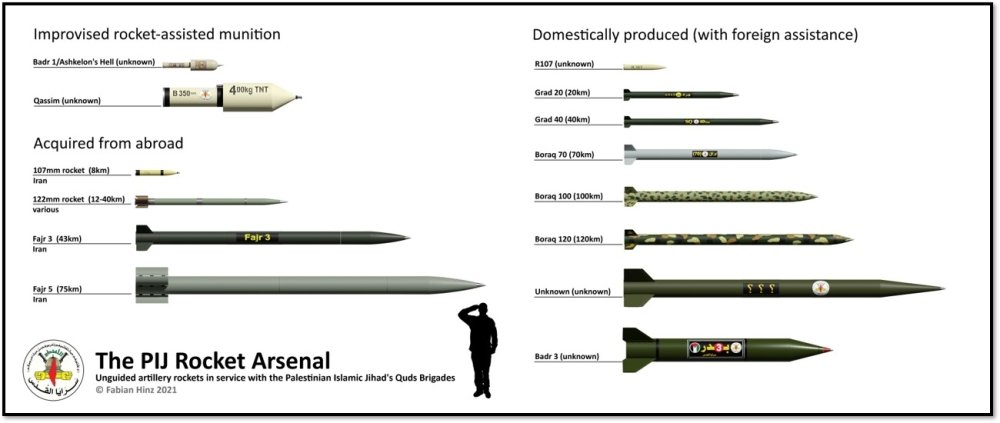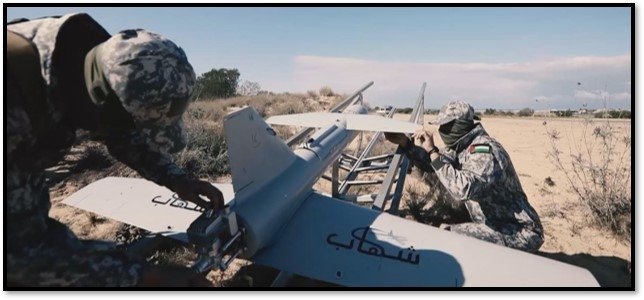Iran Transfers Rockets to Palestinian Groups (original) (raw)
What weapons has Iran provided to Hamas and Palestinian Islamic Jihad (PIJ) in Gaza?
Iran first established ties with Hamas and PIJ in the 1980s. Iran has since provided funding, weapons and training to the militant groups. Iran has transferred several types of artillery rockets — including Fajr 3 and Fajr 5 rockets as well as M302s originally made in Syria — to Gaza.
Since 2006, Tehran has increasingly focused on supplying its regional allies and proxies, including Palestinian factions, with the knowhow and equipment to produce rockets locally. Islamic Revolutionary Guard Corps (IRGC) commanders have publicly said that their priorities are to improve their allies’ ability to operate Iranian-delivered rockets and build rockets and missiles. “Instead of giving them a fish or teaching them to catch a fish, we taught our allies and friends how to make a hook, and they are now in possession of missile capabilities and technologies,” General Amir Ali Hajizadeh, the commander of the IRGC Aerospace Force, said during an interview in January 2021. “Today, the Palestinians fire rockets instead of throwing stones.” There are also indications that Iran is custom-designing simple rocket systems for production in places like Gaza and Iraq.

How has Iran transferred rockets or other weapons to Palestinians given that Egypt has largely destroyed or sealed tunnels that connect Gaza to the Sinai Peninsula?
Historically, Iran smuggled weapons via Sudan, where the IRGC Qods Force operated warehouses and where some rocket production on behalf of Palestinian factions might have taken place. From there, the rockets were smuggled via Egypt through tunnels from the Sinai Peninsula into Gaza. But in the last several years, smuggling weapons via that route has become difficult. Egypt has sealed or destroyed many tunnels since 2013. Iran and Sudan had good relations dating back to the 1980s. But in 2015, Sudan began to warm to Saudi Arabia, Iran’s main regional rival. In 2016, Khartoum cut diplomatic relations with Tehran. Nevertheless, there are indications that smuggling continues, both via undiscovered tunnels and by sea.
How have the Palestinian capabilities improved in recent years? In what ways?
Hamas and PIJ have significantly improved their tactics as well as their ability to launch large quantities of rockets. The pace of rocket launches and the firing of whole volleys against far-away targets — including Tel Aviv (70 km or 45 miles from Gaza) — in May 2021 was unprecedented. The launches have also constituted a real stress test for Iron Dome, Israel’s missile defense system that intercepts low-altitude and short-range missiles and rockets. Most of the rockets that have been launched from Gaza seem to have been domestically produced.

How do the weapons used by Hamas and PIJ in 2021 compare to those used during the 2014 conflict with Israel? Have the rockets changed in terms of range, precision or payload?
The Palestinian groups have unveiled a few new rocket systems, but none of them qualified as a game changer. Hamas unveiled the Ayyash 250 rocket with a range of 250 km (155 miles), the longest-range rocket ever shown in Gaza. While its production is technically impressive, its military value is limited by extremely low accuracy and the fact that most important targets in Israel are much closer to Gaza. Jerusalem, for example, is only 77 km (48 miles) away from Gaza.
PIJ extensively used the Badr 3 rocket, which appears to have been designed and tested in Iran, during the 2021 conflict. First unveiled by PIJ in 2019, the rocket carries a warhead weighing between 300 kg and 400 kg (661 pounds to 882 pounds), which is much heavier than warheads of most Palestinian rockets. The heavier the warhead, the larger the explosion. But the rocket appears to be middling in terms of range. In May 2021, PIJ struck the Israeli cities of Ashkelon and Netivot with the Badr 3, indicating that it has a range of at least 13 km (8 miles).
The Badr 3, which is not sophisticated, may have been designed in Iran specifically for proxies across the Middle East to produce locally. The Badr 3 is almost identical to the al Qassim rocket displayed by the Technical Directorate for Military Production (TDMP), an arms manufacturer affiliated with Iraq’s Popular Mobilization Forces, an umbrella of militias, including several Shiite groups backed by Iran. Leaked documents, including technical diagrams for the Badr-3 in both English and Farsi, also suggested a link to Tehran. In May 2021, PIJ’s spokesman thanked the “Resistance Axis headed by Iran” for the Badr 3.

Crucially, Hamas and PIJ have yet to indicate that they possess precision-guided rockets, which would dramatically improve the rockets’ military utility. Perhaps the most interesting weapon system revealed during the conflict was the Hamas Shehab suicide drone, which constitutes the first instance of a precision-guided munition in Gaza. A suicide drone, also known as a loitering munition, can hover near a target and either explodes near it or detonate on impact.
Fabian Hinz is an independent open source intelligence expert focused on missile proliferation in the Middle East and North Africa.